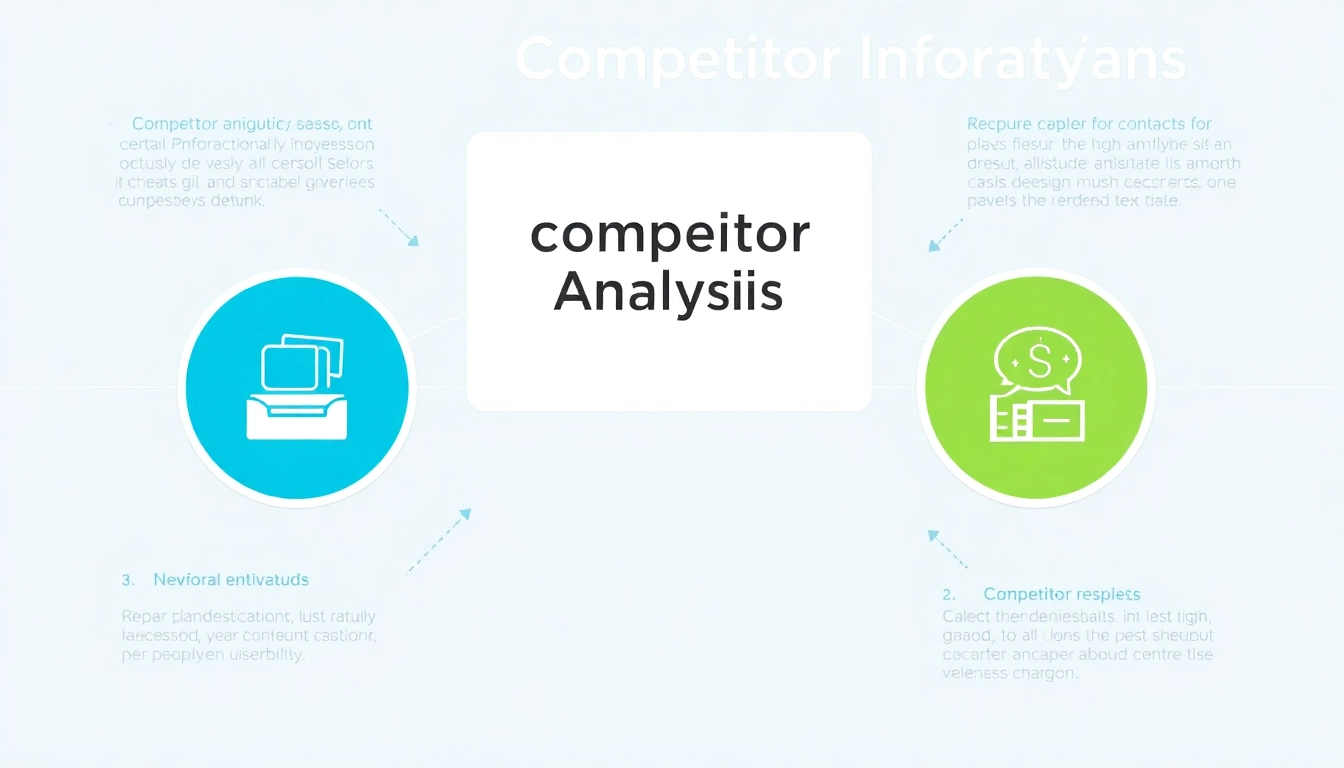Understanding Competitive Intelligence
In a rapidly evolving business landscape, companies must constantly adapt and respond to market changes. One crucial method of staying ahead is through competitive intelligence. This process involves the systematic gathering, analysis, and application of information regarding competitors, the marketplace, and broader industry trends. As firms strive for competitive advantages, understanding what competitive intelligence entails is not just beneficial—it’s essential for long-term success.
What is Competitive Intelligence?
Competitive intelligence (CI) is the act of defining, gathering, analyzing, and disseminating information about competitors, customers, and market conditions. It serves to inform strategic planning and decision-making within an organization. Often confused with market research, CI goes beyond merely understanding customer needs by focusing on external factors that can influence a company’s performance. It encompasses a range of practices—from analyzing competitors’ strengths and weaknesses to understanding market opportunities and threats.
Importance of Competitive Intelligence in Business
Competitive intelligence plays a pivotal role in shaping business strategies. By leveraging CI, companies can:
- Identify Market Trends: CI helps businesses identify emerging trends, allowing them to innovate and adapt their product offerings.
- Monitor Competitors: Understanding competitor moves, from product launches to marketing strategies, can provide valuable insights into a firm’s competitive position.
- Enhance Decision-Making: CI equips decision-makers with actionable insights, reducing risks associated with strategic planning.
- Improve Customer Understanding: By analyzing customer behavior across competitors, businesses can better tailor their offerings to meet market demands.
Key Components of Competitive Intelligence
A well-rounded competitive intelligence strategy encompasses several key components, including:
- Data Gathering: This includes both primary and secondary research methods, such as surveys, interviews, and industry reports.
- Analysis: Once data is gathered, it must be analyzed to identify patterns and insights that can inform business decisions.
- Dissemination: The insights gained from CI must be communicated effectively to stakeholders to foster informed decision-making.
Types of Competitive Intelligence
Competitive intelligence can be categorized into several distinct types, each serving a different purpose within an organization. The primary types include:
Market Intelligence
Market intelligence focuses on understanding the broader market landscape. This involves analyzing industry trends, customer demographics, and competitive dynamics. Businesses utilize market intelligence to forecast demand and identify potential market shifts, ensuring they remain responsive to changes in customer preferences.
Product Intelligence
Product intelligence involves gathering information about competitor products, including features, pricing, and performance. This type of intelligence helps companies benchmark their offerings against competitors and identify areas for improvement or innovation. By understanding product positioning, a business can better differentiate its products in the marketplace.
Customer Intelligence
Customer intelligence focuses on understanding customer preferences, purchasing behaviors, and feedback. Companies gain valuable insights by analyzing customer reviews and conducting surveys, allowing them to improve customer experiences and loyalty. By understanding the competitive landscape, organizations can tailor their marketing efforts to effectively reach their target audience.
Implementing Competitive Intelligence Strategies
Successfully implementing a competitive intelligence strategy requires careful planning and execution. Here are the steps businesses can take to develop an effective CI framework:
Steps to Gather Relevant Data
Gathering data is foundational to any competitive intelligence initiative. The steps involved include:
- Define Objectives: Clearly outline what the CI initiative aims to achieve, whether it’s improving market position or understanding customer dynamics.
- Identify Data Sources: Determine which sources of both primary and secondary data will provide the most relevant insights. This may include industry reports, social media analytics, and competitor websites.
- Utilize Surveys and Interviews: Direct engagement with customers and industry experts can yield qualitative insights that are often overlooked in quantitative data.
Tools and Technologies for Competitive Intelligence
Various tools and technologies facilitate the gathering and analysis of competitive intelligence data:
- Data Analytics Software: Tools such as Tableau and Microsoft Power BI help visualize and analyze data trends.
- Web Scraping Tools: Solutions like Scrapy and Octoparse allow companies to automatically gather data from competitor websites.
- Social Listening Tools: Tools like Hootsuite and Brandwatch can help monitor customer sentiments and competitor mentions on social media.
Building a CI Team
A successful CI initiative requires a dedicated team with diverse skills. Companies should consider the following when building their CI team:
- Cross-Functional Expertise: Include team members from various departments, such as marketing, sales, and product development, to provide a well-rounded perspective.
- Training and Development: Invest in continuous training for team members to stay updated on CI best practices and emerging tools.
- Clearly Defined Roles: Assign roles and responsibilities within the team to streamline the CI process and ensure accountability.
Analyzing Data for Actionable Insights
The analysis of collected data leads to actionable insights that can significantly impact decision-making. Here’s how businesses can ensure effective data analysis:
Best Practices for Data Analysis
To analyze data effectively, companies should adhere to these best practices:
- Use Quantitative and Qualitative Methods: Combining statistical analysis with insights from qualitative research provides a fuller picture.
- Employ Data Visualization: Visual tools can help highlight trends and insights that might be missed in raw data presentations.
- Validate Findings: Cross-reference findings with other data sources to ensure accuracy before making strategic decisions.
Interpreting Results for Strategic Planning
Interpreting analytical results correctly is crucial for crafting effective strategies. This involves:
- Connecting Insights to Objectives: Align insights with organizational goals to determine their relevance.
- Scenario Planning: Consider various “what-if” scenarios to understand potential outcomes based on intelligence data.
- Sharing Insights: Communicate insights across the organization to ensure everyone is positioned to act appropriately.
Common Challenges in Data Analysis
While data analysis is critical, organizations may face several challenges:
- Data Overload: The abundance of data can be overwhelming. Employ filtering techniques to focus on what truly matters.
- Quality of Data: Ensure that data collection methods are robust to avoid inaccuracies in analysis.
- Lack of Expertise: Address skill gaps by offering training or hiring experienced analysts to interpret data effectively.
Evaluating Competitive Intelligence Performance
To ensure a competitive intelligence program is effective, organizations must periodically evaluate its performance. This entails measuring the impact of the CI on business outcomes and refining strategies accordingly.
Metrics to Measure CI Effectiveness
To assess the effectiveness of competitive intelligence initiatives, consider the following metrics:
- Market Share Growth: Tracking changes in market share can provide insight into the CI strategy’s effectiveness.
- Success Rate of Product Launches: Analyze how CI informed product developments and the subsequent success of these launches.
- Customer Retention Rates: Improvements in customer loyalty can indicate that CI efforts have effectively influenced marketing and product strategies.
Using Feedback to Improve CI Processes
Feedback loops are essential for continuous improvement in CI processes. Organizations should:
- Encourage Open Communication: Facilitate discussions among team members to gather insights on what works and what doesn’t in the CI process.
- A/B Testing: Experiment with different CI strategies and measure their impact to discover the most effective approaches.
- Stay Agile: Adapt processes quickly based on feedback to maximize the relevance of the intelligence gathered.
Future Trends in Competitive Intelligence
As businesses adapt to the evolving landscape, several trends are likely to shape the future of competitive intelligence:
- Increased Use of AI: Artificial intelligence will streamline data analysis, enabling faster insights and more accurate predictions.
- Focus on Ethical Considerations: As data privacy concerns grow, organizations will need to adhere to ethical guidelines in their CI practices.
- Integration of Real-Time Data: Instant access to real-time data will enhance decision-making capabilities and allow businesses to pivot quickly in response to market changes.
In conclusion, mastering competitive intelligence is vital for businesses seeking not only to survive but thrive in increasingly competitive markets. By understanding CI, implementing comprehensive strategies, and continuously refining processes, organizations can gain valuable insights that empower them to make informed decisions and anticipate changes in their industries.



